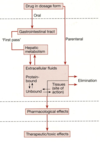Pharmacokinetics Concepts Flashcards
(134 cards)
What is pharmacokinetics?
The study of movement of a drug into and out of the body - the study of what the body does to the drug
What is pharmacodynamics?
The study of drug effect and the mechanisms of action - what the drug does to the body
What is pharmacogenetics?
The effect of genetic variability on the pharmacokinetics, or the dynamics of a drug on an individual
What are the main processes involved in drug therapy?
- Pharmaceutical process
- Pharmacokinetic process
- Pharmacodynamic process
- Therapeutic process
What question is asked when considering the pharmaceutical process?
Is the drug getting into the patient
What question is asked when considering the pharmacokinetic process?
Is the drug getting to its site of action
What aspects does the pharmacokinetic process consist of?
- Absorption
- Distribution
- Metabolism
- Elimination
What question is being asked when considering the pharmacodynamic process?
Is the drug producing the required pharmacological effect?
What question is being asked when considering the therapeutic process?
Is the pharmacological effect being translated into a therapeutic effect?
Draw a diagram illustrating the relationship between pharmaceutical process, pharmacokinetic process, pharmacodynamic process, and therapeutic process

Draw a diagram illustrating the stages of ADME in relation to a time-concentration graph

What is meant by oral bioavailability?
The fraction of a dose which finds its way into a body compartment, usually the circulation
What is the bioavailability for an intravenous bolus?
100%
How is the bioavailability worked out for all other routes apart from IV?
You compare the amount reaching the body compartment by that route with intravenous bioavailability
Give the equation for the calculation of oral bioavailability?
= area under the curve (oral) / area under the curve (IV)
What is meant by area under the curve when calculating oral bioavailability?
The area under the curve of plasma concentration x time post dose - this is the total drug exposure
What factors affect bioavailability?
- Drug formulation
- Age
- Food
- Vomiting/malabsorption
- Fire pass metabolism
What is first pass metabolism?
Any metabolism occuring before the drug enters the systemic circulation
In what locations can first pass metabolism occur?
- Gut lumen
- Gut wall
- Liver
What produces the first pass metabolism effect in the gut lumen?
- Gastric acid
- Proteolytic enzymes
- Grapefruit juice
What drugs are affected by the first pass metabolism in the gut lumen?
- Benzylpenicillin
- Insulin
- Ciclosporin
What produces the first pass affect in the gut wall?
P-glycoprotein efflux, which pumps drugs out of the intestinal entrocytes and back into the lumen
What drugs are affected by first pass metabolism in the gut wall?
Ciclosporin
What produces the first pass effect in the liver?
Drugs get oxidised and conjugated


